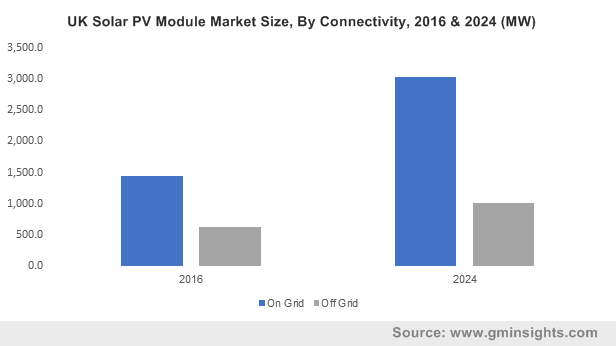Solar PV module market to witness massive growth via utility sector, favorable governmental initiations in terms of tax incentives to boost the industry expansion
Publisher : Fractovia | Published Date : 2017-06-01Request Sample
Worldwide, solar PV module market has been charting an exponential growth curve over the past few years. Solar PV or photovoltaics system has evolved from a niche market of small-scale application to a mainstream electricity source. Favorable incentives such as feed-in tariffs, tax subsidy, soft loans that are being implemented by governments of both developing and developed nations are further mobilizing the industry expansion. Of late, clean energy claim has observed a comprehensive upsurge with growing urbanization and solar power demand at the pinnacle. Regulatory compliance on renewable energy integration in the electricity grid has opened lucrative business opportunities for solar PV module market to expand its horizon. As per a report by Global Market Insights, Inc., “Global Solar PV module industry which held a business of USD 20 billion in 2016, is slated to exceed USD 30 billion by 2024, with a projected annual installation of 100 GW power by 2024.”
Technological progression has always played a pivotal role in the exploitation of renewable energy sources, solar energy being no exception. With the intervention of technology, solar PV module market has experienced an enrichment with upgraded manufacturing methods that have complemented the business landscape. Scientific interventions in manufacturing facilities and financial leveraging have led to a decline in the overall market price trends. As per records, in 2016, average solar panel price experienced a drop of more than 20% in comparison to 2015. Alongside, strong global concern about catastrophic consequences of greenhouse gas emission on the environment has brought a dramatic shift in solar PV module market dynamics. Government’s noticeable initiations across the globe pertaining to the replacement of fossil fuel oriented plant with clean energy resources have catered the market commercialization.
North America Solar PV Module Market Size, By Product, 2016 (MW)

Increasing research investments in cost competitive technology along with monetary assistance by renowned foundations that include Asian Development Bank (ADB), the World Bank, and IFC (International Finance Corporation) have propelled the crystalline silicon-based solar market demand. For instance, recently, DuPont Photovoltaic Solutions have come up with their latest launch named DuPont Solamet photovoltaic metallization paste which is reported to have a module efficiency of almost 21.15%. Thin film photovoltaics held one-fifth of the overall solar PV module market share in 2016. Flexible integration and improved operational efficiency are the two major grounds that are boosting the thin films solar cells market.
Attributing features such as high efficiency, low toxicity, and comparatively affordable operational cost have enabled solar PV module industry to widen its application landscape. Driven by the growing financial assistance initiated by the Government which includes tax credit, easy availability of soft loans, low import duty, solar PV module market from utility sector has witnessed a substantial growth globally in recent years. In the first quarter of the year, Vietnam’s Ministry of Industry and Trade have talked about their FiT scheme related to utility-based solar power projects. Ongoing electrification programs and incentives benefit pertaining to grid connected power generation is surging the demand for on-grid solar PV modules. On-grid connection represented 55% of the overall solar PV module industry in 2016 and is expected to continue its prominence in the years ahead also.
Residential sectors are also widely deploying solar PV panels, on account of exploiting the financial and technical benefits such net metering, tax rebates, and subsidies imposed by the government for roof top installations. Residential solar PV module market, in 2016, recorded a revenue of USD 4 billion.
In terms of geography, Asia Pacific is anticipated to represent a significant portion of the overall Solar PV module industry in the next few years, with China as the major revenue pocket. China covered almost 60% of the overall market in 2016. The region’s growing focus on renewable energy integration coupled with ongoing energy conservation programs have catered the market growth. Furthermore, China Energy Agency’s announcement of investing a huge amount in renewable technology in the next three years is expected to further stimulate overall APAC solar PV module market. U.S. will also record steady gains in the coming time frame. The projection is grounding on the country’s increasing investments in optimizing the renewable energy sources along with mandatory roll outs regarding minimization of greenhouse gas emissions. Taking into consideration the country’s increasing deployment of micro-grid network and growing adoption of sustainable energy, solar PV module market in U.S. is expected to grow significantly at a CAGR of 6% over 2017-2024.
The progress of solar PV module market is extremely dynamic and differs strongly by geographies. While many industrialized countries have already installed solar panels into their electric grid as a substitute for conventional energy sources, there are many underdeveloped nations that have shifted to solar power to avoid their dependence on expensive imported fuels. Some of the prominent solar PV module industry participants include Canadian Solar, JA Solar, Yingli, Jinko, First Solar, Hanwha Q-Cell, SFCE, SunPower, ReneSola, Vikram Solar, Lanco, GCL, Motech, and Hareon.